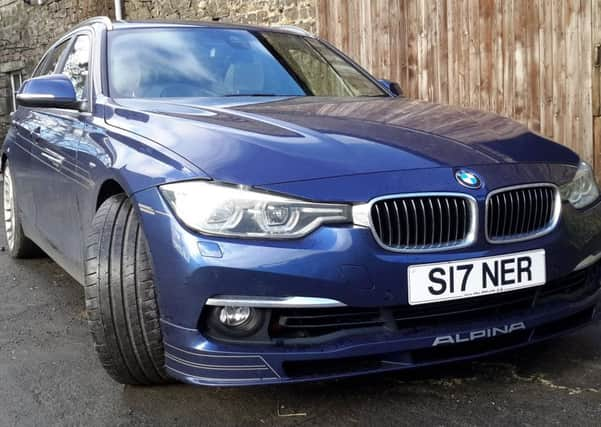Review: could you keep your licence driving an Alpina BMW?


So, plenty of track and pop memorabilia is invested in the Sytner name. Alpina is another child of the Swinging Sixties. It dates from 1965, founded by Burkard Bovensiepen, a member of a well-connected family. It is based in Bavaria and its cars are recognised as a stand-alone brand in Germany.
It works closely with BMW, sharing its production line for installation of its special engines. Alpina cars won the 1970 European Touring Car Championship, the German hill climb title, and track races including Spa 24 before pulling out of racing in 1988 to concentrate on its road cars. Ten years later Alpina and BMW were racing diesel cars, with a BMW 320d winning the Nurburgring 24. It was the first win by a diesel car in a major 24-hour race.
Advertisement
Hide AdAdvertisement
Hide AdAlpina goes head to head with BMW’s own M Sport cars but can be embellished with bespoke leather interiors and have Alpina’s take on brakes, suspension and tuning of the original BMW components.
Using turbocharging and bespoke engine mapping, Alpina achieves very high torque – the ingredient which is as important as horse power for acceleration and engine flexibility.
For example, the 3-litre twin turbo Alpina B3 version of the 3-series 3-litre petrol straight six produces 404bhp at 5500rpm and 442 lb ft of torque at 3,000rpm. The BMW M3 delivers 425bhp at 5,500rpm and 405 lb ft at 1,850rpm. Take your pick but note that on paper at least the Alpina is more economical on fuel and CO2.
Bald performance figures are 0-62mph in 4.2 seconds, 190mph, 37.2mpg and 177g CO2 for the Alpina, and 4.3 seconds, 155mph (factory restricted), 32.1mpg and 204g for the M3.
Alpina does a similar transformation with the 335d twin turbo 3-litre diesel engine in the D3, tested here in the s-series estate car body. It achieves a remarkable 344.6bhp and 516 lb ft, with ratings of 52.3mpg and 142g. This diesel dog carrier will reach 173mph, accelerate to 62mph in 4.6 seconds but the performance monitor on the demo car had even better figures – suggesting the car has reached 181mph, and gone from 0 to 100mph in just 9.9 seconds.
I know, why, why and again why? Readers who question why any car is allowed to go faster than our 70mph speed limit will be aghast. Alpina’s GB brand manager Gary Lott partly explains: “By focusing on just one type of customer – who wants a car that he or she can look forward to driving every day, whether they are commuting to meetings or sensing every nuance of a twisting Alpine pass – they have created a car that is widely regarded as the most broadly accomplished high-performance luxury car available anywhere today.” He admires the “combination of comfort, near-supercar performance, superb quality, low emissions and modest thirst”.
There is truth in all this. The car can be docile – or a rapid charger as the gears change blip, blip, blip and there, you’ve gone illegal.
Alpina says the B3 is for fast road driving (where, please let me know) rather than track. Wherever, and I think that means anywhere you think no one is watching, it’s a complete package with uprated engine cooling, a high carbon and cobalt exhaust manifold to stand up to the heat, an active exhaust system with four large tail pipes. The ZF eight speed gearbox has been revised for the car’s speedy shifts and engine torque. There are extensive changes to the suspension components with Alpina springs, Eibach gas dampers and a body brace fitted. The Brembo brakes use Alpina specification pads. The steering and stability and traction systems are also specific for the car. Keeping it stuck to the ground are Michelin Pilot Super Sport runflat tyres on Alpina’s classic spoked 19-inch wheels. The test car 20-inch wheels with had non-runflat Michelins – 265/30 front, 245/30 rear. Apart from tyre roar and a necessary firmness the ride comfort is very kind.
Advertisement
Hide AdAdvertisement
Hide AdPrices start at £47,950 for the D3 saloon. The estate is £49,950. The petrol B3 saloon is £57,450 and the estate is £58,950. The XD3 SUV, D4 Coupe and Convertible, the D5 saloon and estate and the imminent £115,000 B7 make up the UK Alpina offering.
As tested, the D3 estate costs £65,965. Four-figure extras were a leather interior, leather instrument panel, a limited slip differential, a media pack, glass roof. The bigger wheels and tyres were £860.
Other items included a powered driver’s seat, a hi fi system, head-up display and Alpina’s performance monitor which registers G force, economy etc.
Verdict: It matches the claims. It is phenomenal. How long you’ll keep a clean licence is up to you.